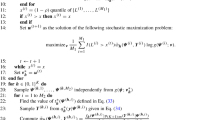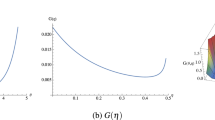Abstract
In many stochastic problems, the output of interest depends on an input random vector mainly through a single random variable (or index) via an appropriate univariate transformation of the input. We exploit this feature by proposing an importance sampling method that makes rare events more likely by changing the distribution of the chosen index. Further variance reduction is guaranteed by combining this single-index importance sampling approach with stratified sampling. The dimension-reduction effect of single-index importance sampling also enhances the effectiveness of quasi-Monte Carlo methods. The proposed method applies to a wide range of financial or risk management problems. We demonstrate its efficiency for estimating large loss probabilities of a credit portfolio under a normal and t-copula model and show that our method outperforms the current standard for these problems.






Similar content being viewed by others
Data Availability
All numerical examples presented in this paper can be reproduced with an R script available from the corresponding author upon request.
References
Adragni K, Cook R (2009) Sufficient dimension reduction and prediction in regression. Phil Trans Math Phys Eng Sci 367(1906):4385–4405
Arbenz P, Cambou M, Hofert M, Lemieux C, Taniguchi Y (2018) Importance sampling and stratification for copula models. Contemporary Computational Mathematics–a celebration of the 80th birthday of Ian Sloan. Springer
Asmussen S, Glynn P (2007) Stochastic Simulation: Algorithms and Analysis. Springer, Berlin
Au S, Beck J (2003) Important sampling in high dimensions. Struct Saf 25(2):139–163
Bassamboo A, Juneja S, Zeevi A (2008) Portfolio credit risk with extremal dependence: Asymptotic analysis and efficient simulation. Oper Res 56(3):593–606
Caflisch R, Morokoff W, Owen A (1997) Valuation of Mortgage Backed Securities Using Brownian Bridges to Reduce Effective Dimension. Department of Mathematics, University of California, Los Angeles. https://doi.org/10.21314/JCF.1997.005
Cambou M, Hofert M, Lemieux C (2016) Quasi-random numbers for copula models. Stat Comput 27(5):1307–1329. https://doi.org/10.1007/s11222-016-9688-4
Chan J, Kroese D (2010) Efficient estimation of large portfolio loss probabilities in t-copula models. European Journal of Oparerational Research 205(2):361–367
Cook R (1998) Regression Graphics. Wiley, New York
Cook R, Forzani L (2009) Likelihood-based sufficient dimension reduction. J Am Stat Assoc 104(485):197–208
Cochran W (2005) Sampling Techniques, 3rd edn. Wiley, New York
De Boer P, Kroese D, Mannor S, Rubinstein R (2005) A tutorial on the cross-entropy method. Ann Oper Res 134(1):19–67
Dick J, Pillichshammer F (2010) Digital Nets and Sequences: Discrepancy Theory and quasi-Monte Carlo Integration. Cambridge University Press, Cambridge
Glasserman P, Heidelberger P, Shahabuddin P (1999) Asymptotically optimal importance sampling and stratification for pricing path-dependent options. Math Financ 9(2):117–152
Glasserman P, Heidelberger P, Shahabuddin P (2000) Variance reduction techniques for estimating Value-at-Risk. Manage Sci 46(10):1349–1364
Glasserman P, Heidelberger P, Shahabuddin P (2002) Portfolio value-at-risk with heavy-tailed risk factors. Math Financ 12(3):239–269
Glasserman P, Li J (2005) Importance sampling for portfolio credit risk. Manage Sci 51(11):1643–1656
Härdle W, Hall P, Ichimura H (1993) Optimal smoothing in single-index models. Ann Stat 21(1):157–178
Harris W, Helvig T (1965) Marginal and conditional distributions of singular distributions. Publications of the Research Institute for Mathematical Sciences, Kyoto University Ser A 1(2):199–204
Hörmann W, Leydold J (2003) Continuous random variate generation by fast numerical inversion. ACM Trans Model Comput Simul 13(4):347–362
Ichimura H (1993) Semiparametric least squares (SLS) and weighted SLS estimation of single-index models. J Econ 58(1–2):71–120
Kahn H, Marshall A (1953) Methods of reducing sample size in Monte Carlo computations. J Oper Res Soc Am 1(5):263–278
Karlin S, Taylor H (1975) A First Course in Stochastic Processes vol. 1. Gulf Professional Publishing, Houston
Kole E, Koedijk K, Verbeek M (2007) Selecting copulas for risk management. J Bank Financ 31(8):2405–2423
Katafygiotis L, Zuev K (2008) Geometric insight into the challenges of solving high-dimensional reliability problems. Probab Eng Mech 23(2–3):208–218
Kvalseth T (1985) Cautionary note about R3. Am Stat 39(4):279–285
Lavenberg S, Welch P (1981) A perspective on the Use of Control Variables to Increase the Efficiency of Monte Carlo simulations. Manage Sci 27(3):322–335
Lemieux, C.: Monte Carlo and Quasi-Monte Carlo Sampling. Springer, Berlin (2009). https://doi.org/10.1007/978-0-387-78165-5
Leydold J, Hörmann W (2020) Runuran: R Interface to the ’UNU.RAN’ Random Variate Generators. R package version 0.30. https://CRAN.R-project.org/package=Runuran
Li K (1991) Sliced inverse regression for dimension reduction. J Am Stat Assoc 86(414):316–327
Loeve M (1963) Probability Theory. Van Nostrand, New York
Niederreiter H (1978) Quasi-Monte Carlo methods and pseudo-random numbers. Bull Am Math Soc 84(6):957–1041
Neddermeyer J (2011) Non-parametric partial importance sampling for financial derivative pricing. Quantitative Finance 11(8):1193–1206
Powell JL, Stock JH, Stoker TM (1989) Semiparametric estimation of index coefficients. Econometrica 1403–1430
R Core Team (2020) R: A Language and Environment for Statistical Computing. R Foundation for Statistical Computing, Vienna, Austria. R Foundation for Statistical Computing. http://www.R-project.org
Reinsch C (1967) Numer Math 10(3):177–183
Rubinstein R (1997) Optimization of computer simulation models with rare events. Eur J Oper Res 99(1):89–112
Rubinstein R, Kroesse D (2013) The Cross-entropy Method: a Unified Approach to Combinatorial Optimization. Monte-Carlo Simulation and Machine Learning. Springer, Berlin
Sobol’ I (1967) On the distribution of points in a cube and the approximate evaluation of integrals. USSR Comput Math Math Phys 7(4):86–112. https://doi.org/10.1016/0041-5553(67)90144-9
Sak H, Hörmann W, Leydold J (2010) Efficient risk simulations for linear asset portfolios in the t-copula model. Eur J Oper Res 202(3):802–809
Stoker T (1986) Consistent estimation of scaled coefficients. Econometrica 54(6):1461–1481
Schüeller G, Pradlwarter H, Koutsourelakis P (2004) A critical appraisal of reliability estimation procedures for high dimensions. Probab Eng Mech 19(4):463–474
Wang X, Fang K (2003) The effective dimension and quasi-Monte Carlo integration. J Complex 19(2):101–124. https://doi.org/10.1016/S0885-064X(03)00003-7
Wang X, Sloan I (2005) Why are high-dimensional finance problems often of low effective dimension? SIAM J Sci Comput 27(1):159–183. https://doi.org/10.1137/S1064827503429429
Wang X (2006) On the effects of dimension reduction techniques on some high-dimensional problems in finance. Oper Res 54(6):1063–1078
Wang L, Brown L, Cai T, Levine M (2008) Effect of mean on variance function estimation in nonparametric regression. Ann Stat 646–664
Acknowledgements
The second and third author would like to thank NSERC for financial support for this work through Discovery Grant RGPIN-5010-2015 and Grant RGPIN-238959, respectively. We also thank an anonymous referee for their insightful comments which helped improve this paper.
Author information
Authors and Affiliations
Corresponding author
Ethics declarations
Conflicts of Interest
The authors declare no conflicts of interest.
Additional information
Publisher’s Note
Springer Nature remains neutral with regard to jurisdictional claims in published maps and institutional affiliations.
Appendix
Appendix
1.1 Proofs
Proof of Proposition 1
The mean and variance follow from
and
Asymptotic normality follows from the central limit theorem. Next, we need to find \(g_T\) among all g that give unbiased estimators so that the variance, or equivalently \(\mathbb {E}_g(m^{(2)}(T)w(T))\), is minimal when \(\Psi (\varvec{x})\ge 0\) or \(\Psi (\varvec{x})\le 0\) for all \(\varvec{x}\in \Omega\). Let \(\Omega _{\tiny{\text{ub}}}=\{t\in \Omega _f:m(t)f_T(t)\ne 0\}\). By Jensen’s inequality,
The last inequality follows since \(\hat{\mu }^{\tiny{\text{SIS}}}_n\) is assumed to be unbiased, i.e., \(\Omega _{\tiny{\text{ub}}}\subseteq \Omega _g\) and the fact that \(\sqrt{m^{(2)}(t)}f_T(t)=0\) for \(t\not \in \Omega _{\tiny{\text{ub}}}\) (as \(m(t)=0\) implies \(m^{(2)}(t)=0\) by the assumption on \(\Psi\)). The right hand side of the inequality is a constant independent of the choice of \(g_T\), namely the minimum variance among all SIS estimators. To achieve equality, or equivalently to minimize the variance, set \(g_T\propto \sqrt{m^{(2)}}(t)f_T(t)\) for \(t\in \Omega _{\tiny{\text{ub}}}\) and the claim follows.
Proof of Proposition 2
Let \(\Omega _T^{(i)}=\{t\in (t_{\inf },t_{\sup }): \lambda _{i} \le t < \lambda _{i+1}\}\) where \(\lambda _i=G_T^\leftarrow ( (i+1)/n)\) and note that \(\mathbb {P}(T\in \Omega _T^{(i)})=1/n\) for \(i=1,\dots ,n\). Then
The expression for the variance is a slight generalization of (Glasserman et al. (1999), Lemma 4.1) in that stratification is combined with IS, bit it can be proved similarly. Let \(\eta _{n}(t)\) denote the index i so that \(t\in \Omega _T^{(i)}\). Then
Let \(\xi =\mathbb {E}_g(\Psi (\varvec{X})w(T)\mid T)=m(T)w(T)\) and define the sequence \(\xi _n=\mathbb {E}_g(\xi \mid \eta _n(T))\). Note that the \(\sigma -\)algebra generated by \(\eta _n(T)\) forms an increasing family as n increases through a constant multiple of power two. Observe that \(\mathbb {E}_g(|xi|)<\infty\) and \(\sup _n \xi _n< \mathbb {E}_g(\Psi ^(\varvec{X})w^2(T))=\mathbb {E}_g(m^{(2)}(T)w^2(T))<\infty\). Also, \(\xi _n\) is a martingale if n increases through a constant multiple of powers of two as it is a Doob’s martingale; (see Karlin and Taylor (1975), p. 246). Then using the arguments as in (Glasserman et al. (1999), Lemma 4.1), it follows that \({\text {Var}}_g(\hat{\mu }^{\tiny{\text{SSIS}}}_n)=\sigma _{\tiny{\text{SIS}}}^2/n+o(1)\).
The expression for the optimal density and variance expressions follow as in the proof of Prop. 1 by applying Jensen’s inequality. It remains to show that the SSIS estimator is asymptotically normal, which we show by applying the Lyapunov Central Theorem; (see Kole et al. (2007), p. 134). Let \(m_i = \mathbb {E}_g(\Psi (\varvec{X})w(T)\mid T\in \Omega _T^{(i)})\) and \(v_i^2={\text {Var}}_g(\Psi (\varvec{X})w(T)\mid T\in \Omega _T^{(i)})\). It is easily seen that \((1/n)\sum _{i=1}^n m_i=\mu_{\tiny{\text{SIS}}}\) and \((1/n)\sum _{i=1}^n v_i^2=\sigma _{\tiny{\text{SIS}}}^2+o(1)\). For any \(i=1,\dots ,n\), we have
where the first inequality follows from the \(c_{\tau }\) inequality as in (Loeve (1963), p. 155). The Lyapunov condition is satisfied, since
by the assumption. The Lyapunov Central Limit Theorem together with Slutsky’s Theorem implies \((\hat{\mu }^{\tiny{\text{SSIS}}}_n-\mu _{\tiny{\text{SIS}}})/\sqrt{n}\underset{}{\overset{\tiny {\text {d}}}{\rightarrow }}{\text {N}}(0,\sigma _{\tiny{\text{SSIS}}}^2)\).
Proof of Proposition 3
Recall that \(T_i\) satisfies \(T_i = G_T^\leftarrow ( (i+U_i-1)/n)\) where \(U_i\overset{\tiny {\text {ind.}}}{\sim }\text {U}(0,1)\) for \(i=1,\dots ,n\), and are therefore ordered, i.e., \(T_1<T_2<\dots <T_n\). For any \(i=1,\dots ,n\),
for some \(\xi _i\in (T_i, T_{i+1})\), which implies that for any continuously differentiable function h, \(h(T_{i+1})=h(T_i)+\mathcal {O}(1/n)\). Then we have
and so
which means that
which shows consistency.
Proof of Proposition 4
We use that \((\varvec{X}\mid T = t) \sim {\text {N}}_d(\varvec{\beta }t,I_d-\varvec{\beta }\varvec{\beta }^{\top })\)(see Harris and Helvig (1965), Theorem 1) to compute the moment generating function of \(\varvec{X}\). For \(\varvec{a}\in \mathbb {R}^d\),
By uniqueness of the moment generating function, \(\varvec{X}\sim {\text {N}}_d(c\varvec{\beta }, I_d+(\sigma ^2-1)\varvec{\beta }\varvec{\beta }^{\top })\).
Rights and permissions
About this article
Cite this article
Hintz, E., Hofert, M., Lemieux, C. et al. Single-Index Importance Sampling with Stratification. Methodol Comput Appl Probab 24, 3049–3073 (2022). https://doi.org/10.1007/s11009-022-09970-1
Received:
Revised:
Accepted:
Published:
Issue Date:
DOI: https://doi.org/10.1007/s11009-022-09970-1




